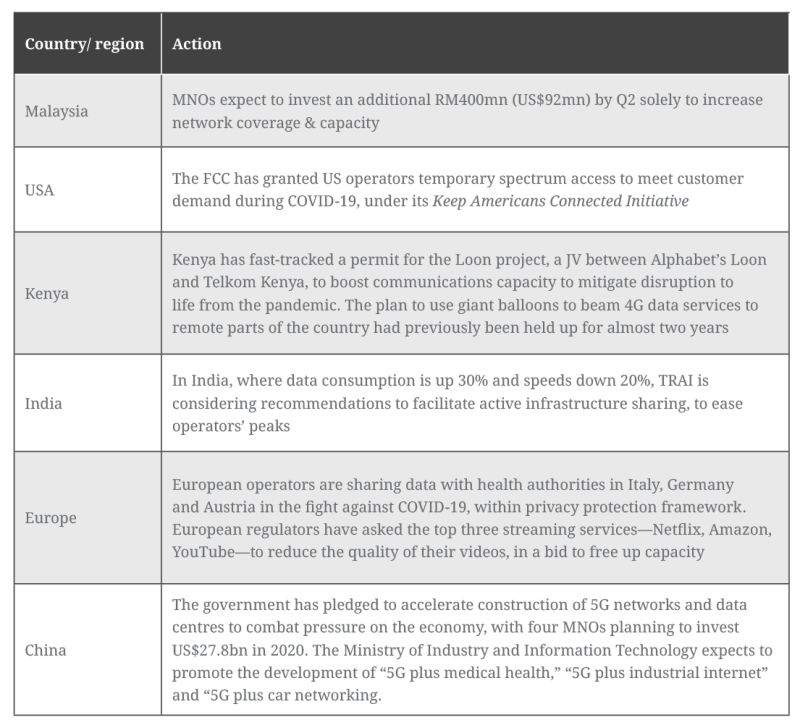Following the Covid-19 outbreak, TowerXchange was delighted to speak to one of the tower industry’s leading visionaries, Gayan Koralage, edotco’s Director of Group Strategy to understand the potential impact shifting data usage patterns could have on the sector. Hear Gayan explains the acceleration in the shift to next generation technologies he expects to see, and the role that towercos should play.
Key take homes:
1. The need to switch to next generation technology is accelerated by change in data usage patterns, due to COVID-19
2. The industry will need to be agile with resource allocation, investing in next generation technology to make up for increased capacity demands
3. Collaboration between industry stakeholders is critical to strengthen the ecosystem for next gen tech. Towercos can play a key role here as neutral infrastructure hosts
TowerXchange: What are the impacts of lockdown measures on global data usage patterns and how well service has performed?
Gayan Koralage, Director, Strategy, edotco Group:
Global consumer trends from one third of the global population being locked down show an unprecedented 15-20% surge in per capita mobile data usage. 5% of this came in the traditional peak time of 9-11PM while, surprisingly the remaining 20% has grown during traditional off-peak time (i.e. daytime). There has been a shift in the nature of use towards virtual private networks and video streaming and a growth in web traffic driven by working from home, virtual education, e-commerce, and tele-medicine.
Global data usage patterns show geographic differences based on lockdown policy. When developing countries such as India, South Africa, South-East Asian countries lock down, people turn to their phones for entertainment, communication and work.
With little fixed-line capacity to fall back on in developing countries, the load on local mobile networks is immense. Pre-paid subscriber bases are affected in countries like Pakistan and Bangladesh where top-ups are becoming difficult to purchase during lockdown. But the near-uniform consequence of lockdown is on service speed (see figure one).
Figure one: Near-uniform consequence of lockdown on service speed in edotco Group’s countries of operation

TowerXchange: How will the pandemic impact the shape of radio coverage and capacity required?
Gayan Koralage, Director, Strategy, edotco Group:
The pandemic has led to a paradigm shift in people’s lifestyles: how they eat, work, shop, exercise, manage health, socialise, and spend free time. The digitisation accelerated by COVID-19 will likely permanently change people’s lifestyles, even after a vaccine is found or herd immunity is gained.
This means the mobile industry will need more in-fill capacity in dense, urban areas and further blurring of the active/passive distinction, to meet the shift in mobile network topology.
Players in emerging markets especially, will be chasing the economic shortfall as the pandemic comes under better control and movement restrictions begin to be lifted. They need to shift their focus to deploying these next generation solutions, when the window of opportunity is open during the crisis, so the required infrastructure will be in place to continue supporting data growth needs.
TowerXchange: What disruptive technologies and models should we now be thinking about and how will this impact the ecosystem?
Gayan Koralage, Director, Strategy, edotco Group:
The industry should shift from steel and concrete to next generation technologies wherever possible. The ecosystems’ adoption of next gen solutions must be accelerated now to meet new network demands - multi-technology multi-operator small cells, IBS, innovative partnerships such as with the Telecom Infra Project, partnerships on 5G with MNOs and such will be key initiatives. We must ensure we are having the required conversations to meet the landscape demand changes and upkeep for long-term change requirements.
In terms of solutions, there are seven medium-term opportunities: the use of temporary solutions like Cell on Wheels (COWs) in critical hotspots like hospitals and enforcement agencies; increasing battery capacity in residential areas; increasing high-performance computing capacity; cloud computing; edge computing; improving network quality; and management of network traffic congestion.
If we have regulatory support to accelerate adoption, corporate agility in resource allocation (for example with incremental/rolling budget forecasting to have agility in resource allocation), and we nurture existing innovative partnerships, then the ecosystem can thrive. Industry players will have to shift from the ‘service provider’ to ‘influencer’ role when engaging with authorities; transparency on government and regulatory decision-making on lockdown duration will help businesses take investment decisions accordingly.
The impact on the ecosystem, of doing business during COVID-19 and expected future epidemics, is increased cost. Hence, there is scope for disruption in order to further optimise cost.
The economic recovery for the telecom industry will vary by consumption conditions per market, regulatory support and lockdown duration. Only wealthy economies can afford a prolonged lockdown. Industry and governments are promptly and closely collaborating to improve connectivity (figure two).
Figure two: Select country examples of actions taken by the telecoms industry in response to COVID-19

TowerXchange: What role should the infraco layer be playing?
Gayan Koralage, Director, Strategy, edotco Group:
Infracos will be key in bringing the various parties together. As neutral infrastructure hosts, they are in the right position to discuss, negotiate and partner with the various stakeholders towards creating an ecosystem that is ready for next generation technologies and disruptive business models.
COVID-19 is accelerating the Industrial Revolution 4.0, for the benefit of universal stakeholders and not just the TMT industry. Moving forward ecosystem players must look to:
- Redistribute resources/reprioritise investments, to look at next generation technology deployment
- Use consumer data as a competitive differentiator of business model
- Collaborate with other ecosystem players to fill connectivity gaps faster (instead of competing on price and throughput) as consumers’ disposable income fall
- Collaborate with government, to meet demand for bandwidth & speed, and ensure the right regulatory frameworks are in place, with the goal of seamless connectivity services.

